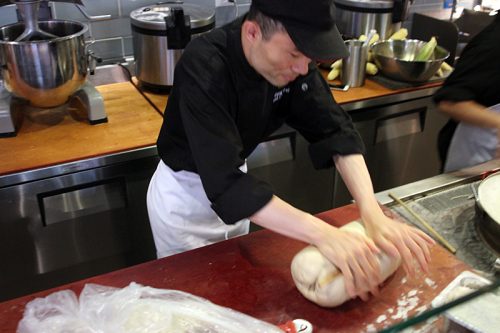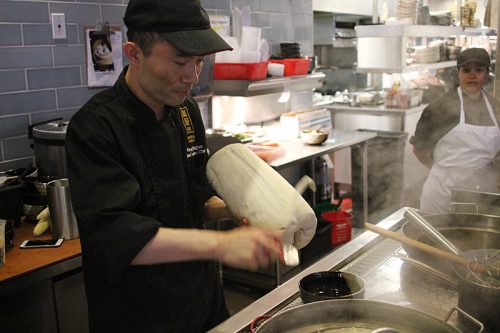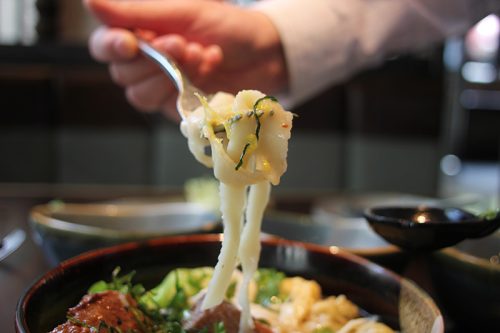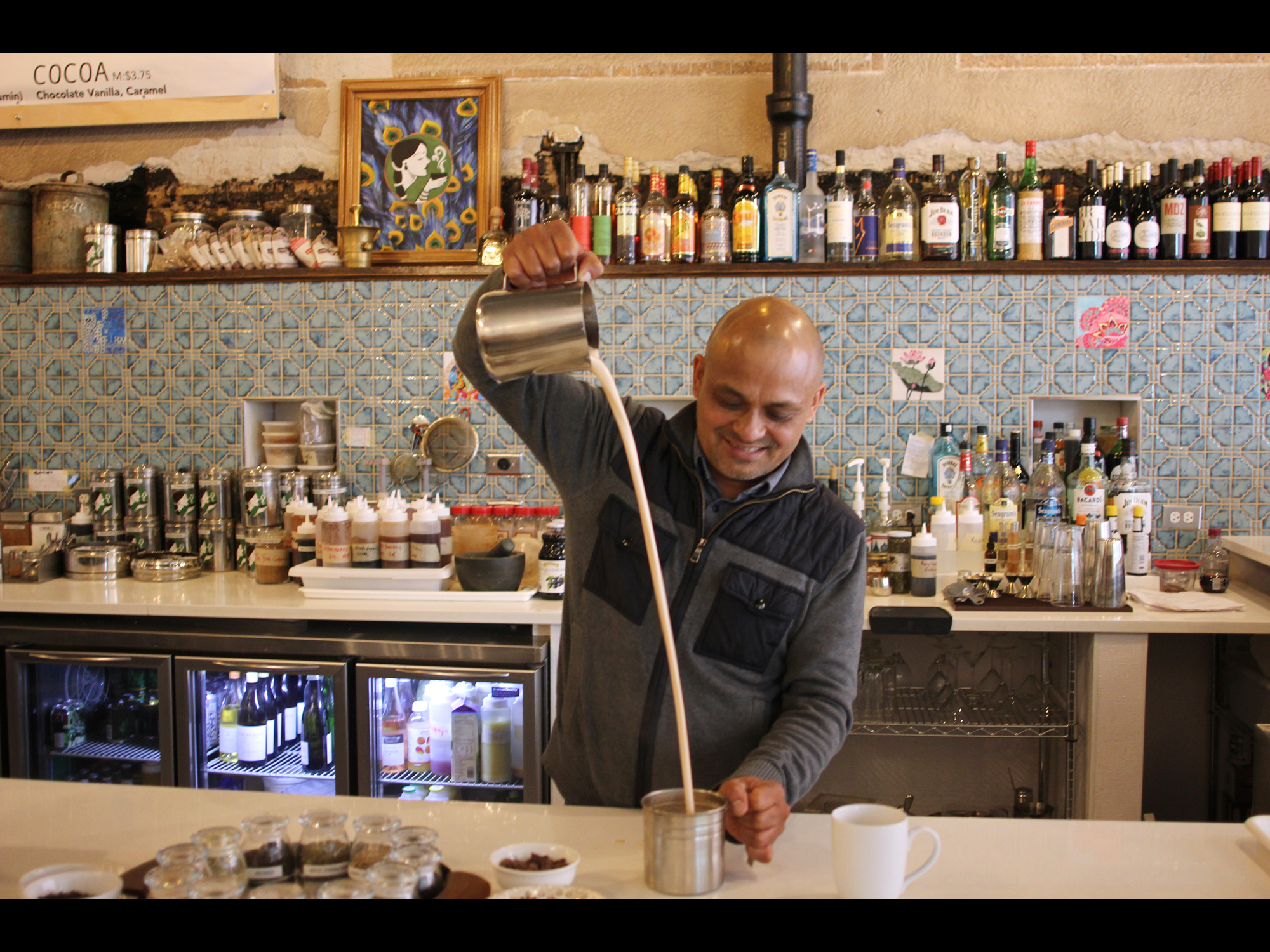LOOKING THROUGH THE PHOTOS I TOOK of Wang Hong Jun slicing noodles from the cylinder of dough the size of a throw pillow, I search in vain for the perfect shot of a freshly-sliced noodle sailing through the air and into the bubbling pot of noodle water. Wang, the restaurant’s la mian master, is just too fast; even in sport mode, shooting half a dozen shots in a row, all I wind up with is a blur of movement over the dough, which he peels noodles off of as you might peel a potato.

Master Chef Wang Hong Jun rolls out the dough
Yet when we get our bowl of soup with handcut noodles a few minutes later, the noodles seem perfect in their imperfection—that is, a little bit irregular, but consistently so, the length of fettucine and varying slightly, with ragged edges. Like a rustic pasta in an Italian restaurant, they’re pleasing, friendly even, in their lack of machine-made uniformity.
Imperial Lamian’s U.S. CEO, Vincent Lawrence, describes what you want in a shaved noodle—”It’s thin at the end and a little thicker in the middle. It’s got this chewiness and springiness—when you bite it it gives you a little kickback. And the cool thing about fresh noodles, they absorb broth so easily, you get a lot of flavor just by enjoying the noodles. Then mixed with the broth and then the protein, it’s just a full experience.”

Noodle in flight
Shaved noodles are not unique to Imperal Lamian in Chicago, but they’re not common either; I know of just one place in Chinatown, Slurp Slurp, that has them right now. Basically you have to already be committed to making your own hand-pulled noodles, which is rare, and then you have to want to make some of them a different way, too. A lot of work for a neighborhood Chinese place to take on, unless it’s the focus of their concept.
Even for Imperial Lamian, a more upscale place named for hand-pulled noodles (“la mian” simply means hand-pulled, and is etymologically related to another noodle soup you may have heard of, ramen), it’s something they’re just experimenting with right now, as I would learn.
Lawrence says shaved noodles are a bit more common in China. Both hand-pulled and shaved noodles (“da xiao man”) come from around the city of Lanzhou, in northwest China—hand-pulled come from Lanzhou, the shaved noodles come from a little to the south. “Being on the north and west side of China, there’s a lot of Muslim population, so beef is the most obvious meat option for them. But once the lamian spread around China, they do all kinds of different protein and broth with it.”
I laugh out loud when I find out how they wound up on the menu here. A few weeks ago I said that Pizzeria Bebu represented a possibly unique example of staff meal winding up on the public menu. Well, maybe not completely unique… Lawrence says, “I knew the hand-shaved noodles existed, but I’d never really had them that much, because we were focusing on the hand-pulled noodles, the lamian. But one night I saw that my lamian chef was shaving his noodles,” for his own dinner. “And I was like, what are you eating? ‘Hand-shaved noodles.’ Okay, give me some. And then I shared them with my managers, and they were like, holy cow, why don’t we have this on our menu?”

Lawrence looked at ways to introduce Wang’s personal dinner special to the menu, but the problem is, it’s not easy to do two styles of noodles in one big boiling pot during a busy service. Looking to boost business during the quiet time between lunch and dinner, and experiment with them at a time when they wouldn’t break the kitchen’s routine, he had the idea of introducing them as an option from 3 to 6 p.m. Monday through Friday, doing a “Build Your Own Lamian” happy hour for $12. You choose your broth, your noodle style and extra toppings—one of the noodle styles being hand-shaven.
I let Lawrence order for us; he chooses beef broth and beef brisket, plus a soy egg to top it. While we waited, I asked him to tell me about how the dough is made. “We use high-gluten flour, mix it with a little bit of egg, a little sugar, a little salt, and some oil,” he explained. “The main process is how we knead the dough. Speaking for the chefs, they feel it. You can really tell how long you knead them, and they know exactly when it’s ready to be pulled.”
“How often do you make the dough?”
“We make a big batch of dough every morning, then make them into medium sized dough, made fresh every single day,” he said.

After a few minutes, our soup comes and Lawrence volunteers to dish it up, apportioning each of us an equal amount of the jagged-edged noodles, the brisket, and the broth, along with a big hunk of baby bok choy. “How do you eat this?” I ask, holding it in my chopsticks.
“You just bite it,” Lawrence replies. I’m relieved, that today I will not embarrass America. The broth is rich; the brisket is tender; and the noodles, well, they’re chewy, they’ve absorbed the flavor of the broth, they have irregular edges… they’re great. If you’re looking for a very late lunch or an early dinner, these noodles have your name all over them.

IMPERIAL LAMIAN is a chain, based in Indonesia; Lawrence is the American CEO, the Chicago location the first in what they hope will be a series of them across America. The aim is to offer an authentic reproduction of what they serve in Indonesia, with a few adjustments to American tastes (maybe they serve the gruyere-filled xiao long bao in Indonesia, what do I know) but a mostly sincere representation of Chinese cooking techniques.
To that end the top staff of the restaurant has all come over from the chain’s outlets in Indonesia, and after we finish our soup, we sit down with lamian chef Wang Hong Jun, but since he doesn’t speak much English, executive sous chef Victor Chong is translating for him. I start by asking Wang, through Chong, how old he was when he learned to make hand-shaved noodles.
Wang is from Lanzhou, originally. “18 years old, when I started to do the noodles.” He says it normally takes a lamian chef a year to learn to make really good noodles, but as Chong tells it in translation, “Sifu Wang says in one week, he learned to make noodles, but not very well. But he is a fast learner. I think in six months he can take care of one noodle shop, do the whole station.”
It takes about 20 to 30 minutes to make a batch of dough using a mixer as well as hand-kneading, and he usually makes three batches each morning, which he says weigh ten kilos—about 20 pounds of dough. (The one he’s kneading in the picture is probably a third of one of the batches.)
I ask him what his choice for the soup is—beef or pork, or what? “Sifu Wang likes the most the pork broth,” Chong translates, “with the mixed mushrooms, vegetables, and noodles.” So which is his favorite kind of noodle? “He says, noodles are his profession, so every noodle, he likes to make it to fulfill our customers.”
So why did he happen to be making that type of noodle when Lawrence saw him? “He says, that is what he makes at home. His family is in China. So those are the noodles he likes to make for them,” Chong translates. If you try the hand-shaved noodles, then, it may be a Happy Hour promotion, but you are also getting chef Wang’s taste of home in Chicago.

Michael Gebert is editor of Si-Fooditor.
COVER: Vincent Lawrence
Latest
Join the Discussion
After you comment, click Post. If you're not already logged in you will be asked to log in or register with Disqus.







